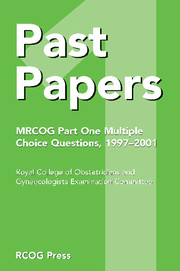Book contents
- Frontmatter
- Contents
- Introduction
- March 1997 – Paper 1
- March 1997 – Paper 2
- September 1997 – Paper 1
- September 1997 – Paper 2
- March 1998 – Paper 1
- March 1998 – Paper 2
- September 1998 – Paper 1
- September 1998 – Paper 2
- March 1999 – Paper 1
- March 1999 – Paper 2
- September 1999 – Paper 1
- September 1999 – Paper 2
- March 2000 – Paper 1
- March 2000 – Paper 2
- September 2000 – Paper 1
- September 2000 – Paper 2
- March 2001 – Paper 1
- March 2001 – Paper 2
- September 2001 – Paper 1
- September 2001 – Paper 2
- Index
March 1999 – Paper 2
Published online by Cambridge University Press: 05 July 2014
- Frontmatter
- Contents
- Introduction
- March 1997 – Paper 1
- March 1997 – Paper 2
- September 1997 – Paper 1
- September 1997 – Paper 2
- March 1998 – Paper 1
- March 1998 – Paper 2
- September 1998 – Paper 1
- September 1998 – Paper 2
- March 1999 – Paper 1
- March 1999 – Paper 2
- September 1999 – Paper 1
- September 1999 – Paper 2
- March 2000 – Paper 1
- March 2000 – Paper 2
- September 2000 – Paper 1
- September 2000 – Paper 2
- March 2001 – Paper 1
- March 2001 – Paper 2
- September 2001 – Paper 1
- September 2001 – Paper 2
- Index
Summary
1. The conversion of glucose to lactic acid
A. occurs in a single enzymatic reaction.
B. is the only pathway for the synthesis of ATP in the red blood cell.
C. is a reversible process in skeletal muscle.
D. is inhibited by high cellular concentrations of ATP.
E. occurs in skeletal muscle when the availability of oxygen is limited.
2. Ketone bodies
A. can be utilised by the fetal brain.
B. include acetoacetate.
C. are water soluble.
D. are synthesised in skeletal muscle.
E. can be utilised during starvation.
3. Noradrenaline
A. is a derivative of arginine.
B. is a precursor of adrenaline.
C. acts predominantly on alpha receptors.
D. is catabolised to vanillylmandelic acid.
E. Is metabolised by catechol-O-methyl transferase.
4. ABO antigens are
A. glycoproteins.
B. found only on erythrocytes.
C. major histocompatibility antigens.
D. not immunogenic during pregnancy.
E. located on membranes.
5. Nitrogen balance is
A. positive during pregnancy.
B. positive during prolonged immobilisation.
C. negative during protein starvation.
D. negative in the untreated diabetic.
E. positive during recovery from debilitating illness.
6. In the fetal lung
A. bronchial cartilage formation commences at 18–24 weeks of gestation.
B. type II alveolar cells first appear at 16—20 weeks gestation.
C. sphingomyelin is the most common phospholipid present at term.
D. phospholipid release is increased by endogenous adrenaline.
E. phospholipid production is decreased by exogenous corticosteroids.
- Type
- Chapter
- Information
- Past Papers MRCOG Part One Multiple Choice Questions1997–2001, pp. 91 - 100Publisher: Cambridge University PressPrint publication year: 2004



